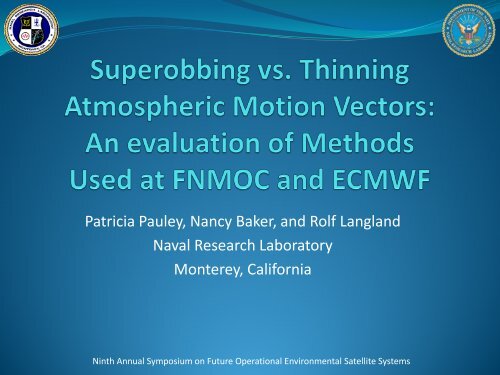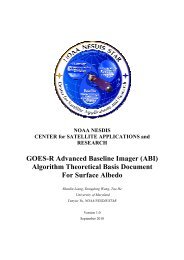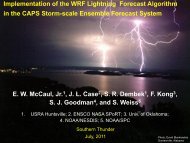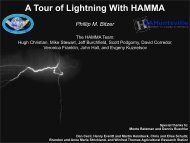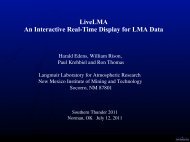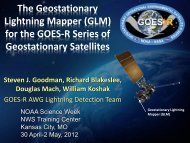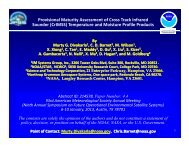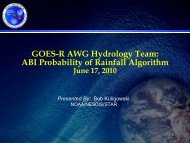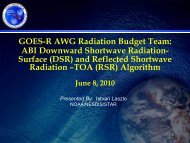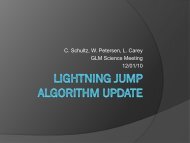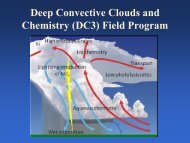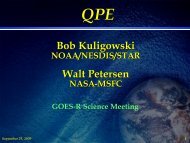Superobbing vs. Thinning Atmospheric Motion Vectors ... - GOES-R
Superobbing vs. Thinning Atmospheric Motion Vectors ... - GOES-R
Superobbing vs. Thinning Atmospheric Motion Vectors ... - GOES-R
You also want an ePaper? Increase the reach of your titles
YUMPU automatically turns print PDFs into web optimized ePapers that Google loves.
Patricia Pauley, Nancy Baker, and Rolf Langland<br />
Naval Research Laboratory<br />
Monterey, California<br />
Ninth Annual Symposium on Future Operational Environmental Satellite Systems
FNMOC and GMAO Observation Impact Monitoring<br />
Current Operations<br />
http://www.nrlmry.navy.mil/metoc/ar_monitor/<br />
http://gmao.gsfc.nasa.gov/products/forecasts/sy<br />
stems/fp/obs_impact/<br />
Much larger relative impact of AMVs in Navy system<br />
2
Motivation<br />
Why does NRL/FNMOC appear to obtain more benefit from<br />
AMVs than other NWP centers?<br />
• <strong>Superobbing</strong> <strong>vs</strong>. thinning<br />
• Assimilating more winds<br />
• Assimilating geostationary winds from NESDIS/EUMETSAT/JMA and from<br />
CIMSS/AFWA—two datasets for each satellite<br />
• Making separate superobs for each processing center, satellite, and channel<br />
• Assimilating hourly winds where available<br />
• Assimilating fewer satellite radiance obs with less impact
Data Overview—CIMSS/UW Winds
AFWA Winds
NESDIS/EUMETSAT/JMA Winds
NESDIS Hourly Winds
Motivation<br />
In experiments using satwinds processed by NRL in the GMAO<br />
system, Gelaro et al. found:<br />
• NRL AMVs provided a substantially increased beneficial impact<br />
and an improvement in overall forecast skill in the GMAO system,<br />
compared to using the NCEP AMVs.<br />
• The greater volume of NRL AMVs appeared to be the primary<br />
reason for the larger impact.<br />
• <strong>Superobbing</strong> also appears to be beneficial, although secondary to<br />
the influence of data volume.<br />
• The smaller impact of NRL AMVs in the GMAO system compared<br />
to their impact in the NRL system appears to result from the<br />
larger number of satellite radiances used in the GMAO system.<br />
From “Impact of Satellite <strong>Atmospheric</strong> <strong>Motion</strong> <strong>Vectors</strong> in the GMAO GEOS-5 Global Data Assimilation System”, by Gelaro, Merkova, McCarty, and<br />
Tai, presented at the 5th WMO Workshop on the Impact of Various Observing Systems on NWP, Sedona, AZ, May 2012 .
Objective<br />
Examine the degree to which superobbing provides a benefit<br />
over thinning<br />
• NAVGEM (Navy Global Environmental Model)<br />
• 4DVAR data assimilation system (NAVDAR-AR)<br />
• T359L50 (approx. 35 km resolution), model top at .04 hPa<br />
• <strong>Superobbing</strong> experiment (FNMOC ops configuration):<br />
• Equal-area prisms (2° lat x 2° lon at the equator), 50 mb deep, within 1 hr<br />
• Obs from the same satellite, channel, processing center used in superobs<br />
• Prisms with winds that vary more than thresholds subjected to outlier<br />
rejection and/or horizontal quartering<br />
• No superobs made in prisms with large variability in the winds<br />
• <strong>Thinning</strong> experiment:<br />
• Same prisms, ob grouping<br />
• Ob with the highest QI selected from same subset of obs that are used to<br />
form superobs, but without quartering
AMV Superob Processing<br />
• Perform QC on individual observations<br />
• Exclude invalid observations with missing position, time, background<br />
• Exclude observations flagged as bad or having low confidence or quality<br />
• EUMETSAT/JMA confidence value less than provided threshold<br />
• NESDIS QI values less than 60<br />
• CIMSS RFF values less than 40 or CIMSS QI values less than 50<br />
• Impose vertical limits as a function of channel<br />
• Impose land-masking in selected regions<br />
• Exclude exact duplicates<br />
• Exclude winds with large vector innovations (ob minus background)
Land Masking<br />
Winds at land points within the North America, Western Europe, and Australia<br />
latitude-longitude boxes are excluded from use.
AMV Limits on Vector Innovations<br />
Winds having large<br />
vector innovation (ob<br />
minus background<br />
values) magnitudes are<br />
rejected.
AMV Superob Processing<br />
• Bin winds into latitude-longitude “prisms” in 50 mb layers<br />
• Examine obs in a prism layer from a particular satellite, channel,<br />
and processing center, and superob if criteria met<br />
• Speeds (or innovations) within 7-14 m/s depending on speed<br />
• Directions (or innovations) within 20° or u and v within 5 m/s<br />
• At least two AMVs are required in a prism<br />
• Reject 1 or 2 outliers to meet criteria if necessary<br />
• Quarter superob horizontally and attempt superobs in each<br />
quarter if the above is unsuccessful<br />
• Adjust u and v superobs so that the magnitude of the superob<br />
wind vector is equal to the mean speed ob the individual obs
Northern Hemisphere Prism Distribution<br />
Superobs are formed in<br />
“prisms” that are 2° latitude<br />
by 2° longitude at the<br />
equator. Although the<br />
latitudinal extent of each<br />
prism is kept fixed at 2°, the<br />
longitudinal extent is<br />
allowed to vary, keeping the<br />
area of the prisms<br />
approximately equal while<br />
also keeping an integer<br />
number of prisms in a<br />
latitude band.<br />
The circles in this figure at<br />
located at prism centers.
<strong>Thinning</strong> <strong>vs</strong>. <strong>Superobbing</strong><br />
The goal of this first test is to compare simple thinning to<br />
superobbing without changing the spatial and temporal<br />
distribution of observations and without changing the number<br />
of observations.<br />
• <strong>Superobbing</strong> experiment—operational processing as<br />
previously described<br />
• <strong>Thinning</strong> experiment<br />
• Process AMVs to generate superobs as previously described<br />
• Replace each superob by the unrejected observation closest in space to<br />
the superob, selected from the observations that were used to form<br />
the superob
Experiment Results<br />
Results are comparable in terms of 500 mb anomaly correlation, with superobbing (green)<br />
having a slight advantage at longer forecast ranges in the Southern Hemisphere.
The 200mb speed<br />
error is slightly less<br />
negative for<br />
superobbing (green)<br />
compared to<br />
thinning (blue)<br />
except in the tropics<br />
where thinning is<br />
slightly better.
The 850mb speed<br />
error is slightly less<br />
negative for<br />
superobbing (green)<br />
compared to thinning<br />
(blue) in the Northern<br />
Hemisphere, but<br />
thinning is slightly<br />
better in the tropics<br />
and Southern<br />
Hemisphere.
<strong>Thinning</strong> <strong>vs</strong>. <strong>Superobbing</strong><br />
The goal of this test is to compare ECMWF-style thinning to<br />
superobbing without forcing the spatial and temporal<br />
distribution of observations and the number of observations to<br />
remain the same.<br />
• <strong>Superobbing</strong> experiment—operational processing as previously<br />
described<br />
• <strong>Thinning</strong> experiment<br />
• Process AMVs to QC and bin obs into prisms as previously described<br />
• In place of superobbing, select a single ob from each prism containing<br />
obs by choosing the ob with the highest QI value. If more than one ob<br />
has this QI, select the first one.
No appreciable difference in the ob counts or statistics between the two file formats
Spatial Distribution of Superobs<br />
70 .. .. ..<br />
.X 2 . 547<br />
.. .2 2 5QQ6<br />
22 .222 2.<br />
.2. .254.2 .2<br />
.. .44.3QQQ73<br />
. 23 . .. 25 .2QQ538<br />
.. .. . 4.2.3.3.25 3<br />
X 2. ..3. 2. .653554852892 4. 34<br />
..22Q2..2. . 2 .2 . .2..44585X3. 2 42<br />
60 2 . ...342.3.. . .3.2. 2..Q2. 23233..576742 2 24<br />
22 33 .24.2 .3.2.2 4. .28X4X663 . 5<br />
.. . . .34. 2.2.2....3.......2.. ..224555. 3.45<br />
... .3.3 .2 . X 24522... 3.Q22.. 3 2. 243. .224453<br />
22. .X.4. 23. ..2..2.. 2 .2244. ..523465636346783<br />
. 2.. . .. .2222 . 2. 22. 22. .322 . . .4752235332435.5.<br />
2..2 .3. . .. ...43 574. . 3.QQ452. ..2 2 3248755246765.4432<br />
3 . 2 . 22 235Q. 3X44. 2 2344232. .2.432.22546. 5423222<br />
. . . .. 3. 32322.2 4552 ..22 .2322233.. .33 2.22263 2<br />
22 2. ..2. 2.3. 9654222.22. . .2. . 2 .. 22 . X .353.. .<br />
50 . ..... . .... .3 4222Q33. ... . . ..245365 ..<br />
5499. .2 2.2.732. 32. 222.. 2 2 33.73 .43.<br />
.3.32 .. .. . 2.. ...6 .. .22Q3Q 3.. .<br />
.26 .2 2.3 2 22.3.... .. . 22 2Q.233 2 24 . ..22<br />
. . 2.2. . .. .2.2 .. . .22 ..22 . 2.2.2Q343.2 .. .<br />
53 . . . 2 .2. ..223.2 2.. 23. 265433<br />
46 .22 .....223.. . . . 2..Q. 2 2. . ... . .2 44544<br />
262 . 22 23.Q . . .... . X . . .32<br />
.5 .2 .. .22. . 32.. 2 Q.. .. . . . .2.2<br />
2 2... . ...2.. . .2 ...22 X . . . . ..2323.<br />
40 2 2.2 . .2 . 2 2.. 2 .. .. .2. 333 .523<br />
22 . 2 .2 ..2 2. ..2.3... . ..22. 2 . 222.2 . 43.<br />
.. 2322 . . .. . X222... . .222..2.223..24.23. .. .<br />
5.. . . . 2 22. .2. ...2 . .. 55 265.2 27.<br />
. . . ..... . ..222. .5443.5.<br />
. .. ... 3. . 4..42 ..7422345 .2<br />
2 . . 22.2. .. .323 . 233242 33. 34245<br />
. . . .. . 23 .. 3352.4 .. . 35<br />
. . 4 . .43.43. 232 ..2. .2 .<br />
. . 2..2 2..32 .. .35 35222<br />
30 . .2. . ....X2..X2 . 2 ...2.4.2..234.3.. ..653<br />
. . . 3.3 ...3222..2 2 2 2 3222323226452 . 23<br />
. .2 . ..23.2.42 .3232 .. 223343222444. ..<br />
. .2.. 2 . 2422232 . .2 2 342.23..<br />
.233 . 2 23232. . 32<br />
32. ... . 2. . . . 23<br />
2. 2<br />
. 2<br />
342<br />
.22<br />
20 .<br />
Legend:<br />
Q Prism was quartered<br />
X No superob was made<br />
. Isolated ob allowed<br />
In the thinning experiment,<br />
no quartering is performed,<br />
but an ob is selected in<br />
every prism, changing the<br />
details of the spatial<br />
distribution relative to the<br />
superob experiment.
No appreciable difference in the superob counts or statistics between the two file formats
Only small differences in the superob counts and statistics between superobbing and thinni


